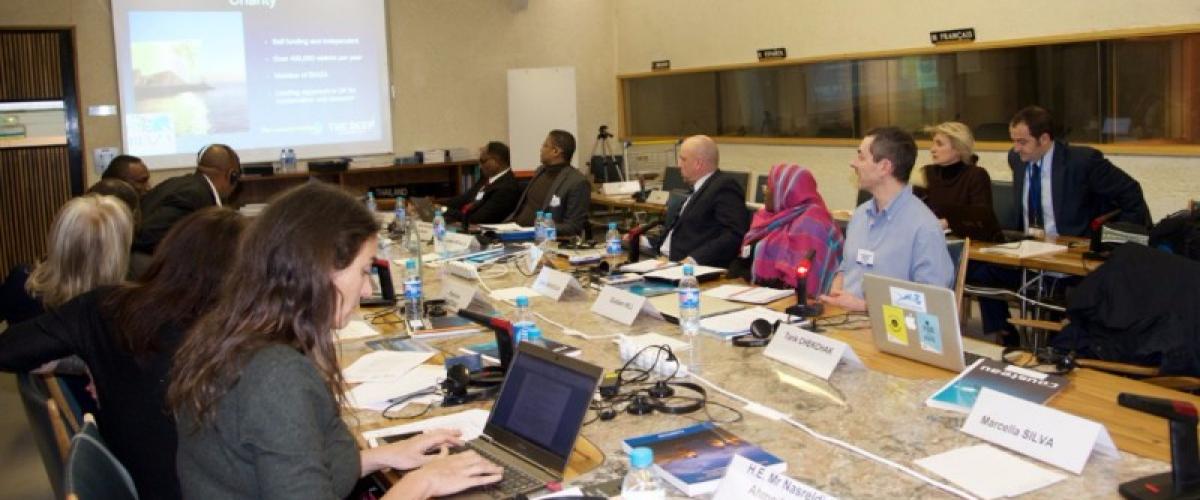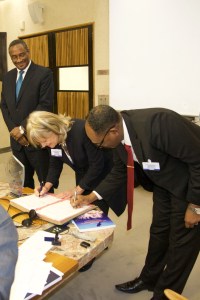Unesco World Heritage Site : Cousteau supports the nomination process of the exeptional sites in the Red Sea coast of Sudan
On 25th February 2016, Cousteau and the Arab Regional Centre for World Heritage (Unesco) organised a meeting of experts convened at UNESCO Headquarters in Paris.
This meeting aimed at strengthening local management capacities and scientific partnership for two marine protected areas: Sanganeb Atoll and Dungonab Bay-Mukkawar Island. Another important goal was encouraging sustainable development and ecotourism to the benefit of local communities. Moreover, the concentration of charismatic species such as manta rays, sharks, dugongs, sea turtles and coral reef ecosystems is a remarkable support to develop ecostourism and to protect its unique marine life.
The meeting gathered a group of international and Sudanese experts representing the Sudanese Red Sea University, the Sudanese Wildlife Conservation General Administration, the Sudanese National Man and Biosphere (MAB) Committee, the Sudanese National Commission for UNESCO, the Regional Organization for the Conservation of the Red Sea & Gulf of Aden (PERSGA); the Sudanese NGO Sudia, The Deep Aquarium (UK), the University of Windsor (Canada) and the International Union for Conservation of Nature (IUCN).
Cousteau in Sudan
This area is also linked to Cousteau’s history since the sixties. In 1963, during the filming of “The World Without Sun”, Cousteau launched the Conshelf II experiment off the coast of Sudan, which aimed to test whether or not humans could live underwater for extended periods of time.
Then, early in the year 2004, the Cousteau vessel Alcyone anchored on the atoll of Shaab Rumi, 40 years after Conshelf II, Captain Cousteau’s pioneering experience in undersea living on that very spot. In late 2003- 2004, Equipe Cousteau undertook an expedition in the Red Sea supported by UNESCO.
The expedition in Sudan provided the opportunity to revisit sites where, 50 years earlier, Cousteau had filmed “The Silent World” (Palme d’Or at the Cannes Film Festival; Oscar in Hollywood) and “World without Sun”. Under the surface, expedition divers discovered an explosion of life and color flourishing in extraordinary seascapes. Later on shore, while visiting Dungonab Bay area, the team was moved by the hospitality of the local Beja people and their poor living condition.
Back on board Alcyone, diver Claude Wesly, one of the original Conshelf oceanauts, who revisited the scene for this mission, looked at Francine Cousteau, President of the Cousteau Society and said “What we accomplished in those days is nothing compared to what we still have to do. This magnificent place simply must be protected, and the local people should benefit from this protection!”.
Every dive site in Sudan, and every landing confirmed this first impression with a succession of brilliant corals, all in fairly good health, and friendly but very poor people. The quality of the shark and rays population was also impressive. Everywhere else in the world, sharks are highly threatened and their populations are shrinking. But in Sudan, the sharks were seemingly still doing very well and attracted divers from all over the world.
In 2007, Cousteau has gathered a multidisciplinary team of scientists to carry out the most comprehensive survey of the Sudanese coast and underwater environment ever to be attempted in this region. During an ambitious month long survey, over 400km of coastline and dozens of islands and offshore reefs were studied. The objective of the survey was to inventory the species, map the habitats with the help of satellite images, and to assess their ‘health’. This information providds the basis for planning for the sustainable management and protection of coastal and marine resources of Sudan.
Find out the entire report of this expedition on :
http://www.cousteau.org/download-iczm-reports/
Currently, Cousteau is working in Sudan to build up the capacity of the Wildlife Conservation General Administration (WCGA), the national authority in charge of the marine protected areas, to actively protect their natural resources.
The program aims to:
- Build scientific knowledge and improve the conservation status of sharks and rays in the Red Sea;
- Engage the people who rely on and impact upon these species in the process by assisting local communities within the boundaries of DMNP to realise the potential benefits of protecting biodiversity through promotion and development of sustainable alternative livelihood programmes such as ecotourism;
- Build national capacity to effectively monitor and manage biodiversity of wide-ranging flagship species such as sharks and rays within the existing Marine Protected Areas and Sudan’s Red Sea.
This project has been awarded in 2015 by the prestigious Darwin Initiative Uk grant.
Follow the Project Sharks and Rays of the Red Sea on :
http://www.cousteau.org/projects/protect-sharks-and-rays-of-the-red-sea/




